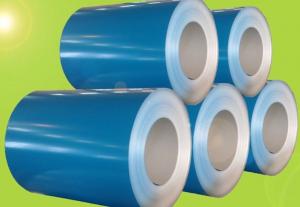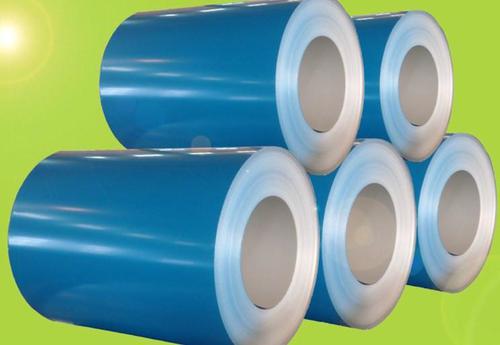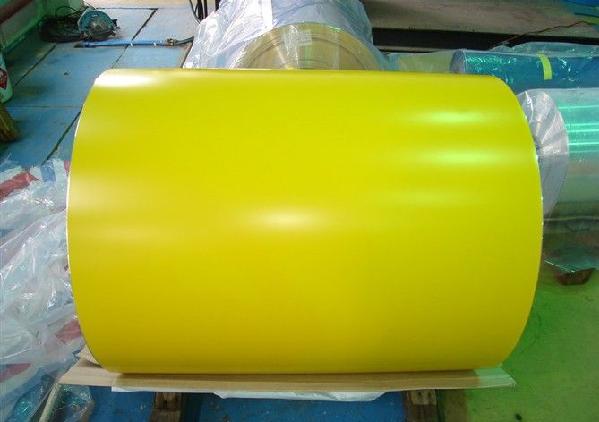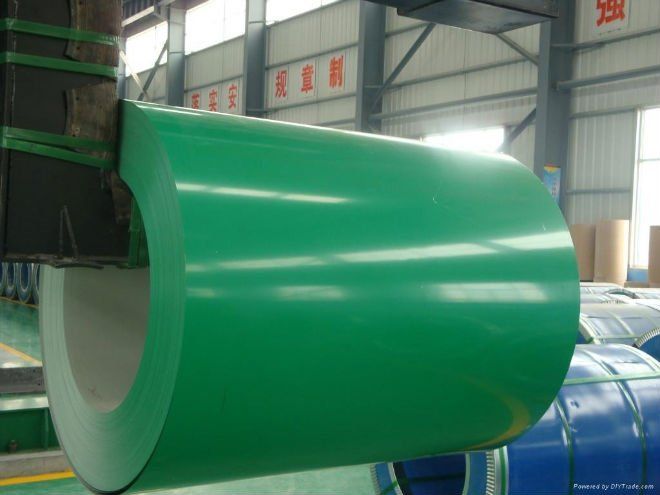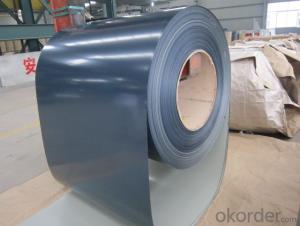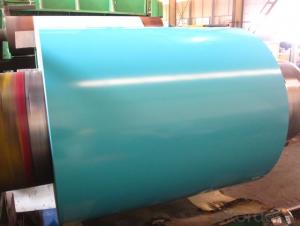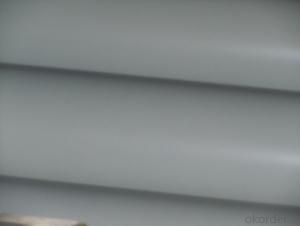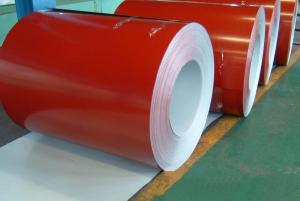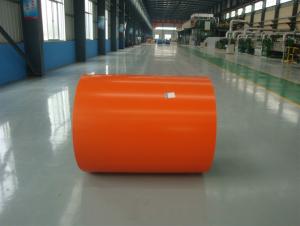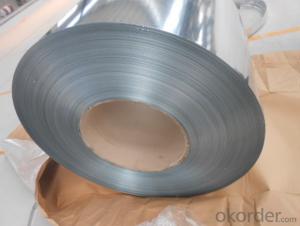Prepainted Hot-Dip Aluzinc Steel Coil
- Loading Port:
- China Main Port
- Payment Terms:
- TT OR LC
- Min Order Qty:
- -
- Supply Capability:
- -
OKorder Service Pledge
Quality Product, Order Online Tracking, Timely Delivery
OKorder Financial Service
Credit Rating, Credit Services, Credit Purchasing
You Might Also Like
Prepaninted Aluzinc Steel Coil(with stamping RAL color No. & ISO9001 on the surface)AZ40G/㎡,TOP: GREEN RAL6020/ BACK: GREY, SHINE SURFACESIZE (MM) FOB CY PRICE (USD/MT)0.30*1000*C 6900.35*1000*C 6700.40*1000*C 6650.45*1000*C 6600.50*1000*C 655VALIDITY: 3 WORKING DAYSPAYMENT: T/T WITH 30% DOWNPAYMENT AND BALANCE AGAINST INVOICE & PACKING LISTSHIPMENT: 50 DAYS FOR CARGO READINESS AND 15 DAYS FOR CATCHING THE RIGHT VESSELOTHERS: ALL WORDS AND SENTENCES SHOULD BE IN ENGLISH
- Q: What are the different types of steel coil cutting processes?
- There are several different types of steel coil cutting processes that are used in various industries. 1. Shearing: This is the most common and simplest method of steel coil cutting. It involves using a shear blade to cut the coil material into desired lengths. Shearing can be done manually or with the help of automated machinery. 2. Slitting: Slitting is a process used to cut wide coils into narrower strips. It involves passing the coil material through a set of circular knives that cut the steel into multiple smaller coils or strips of desired width. 3. Laser cutting: Laser cutting is a highly precise and efficient method of cutting steel coil. It involves using a high-powered laser to melt or vaporize the material along a predetermined path. Laser cutting is commonly used for intricate designs or when high accuracy is required. 4. Plasma cutting: Plasma cutting is another method used to cut steel coil. It involves using a plasma torch that generates a high-velocity jet of ionized gas to melt the material. Plasma cutting is known for its speed and ability to cut through thick materials. 5. Waterjet cutting: Waterjet cutting is a process that uses a high-pressure stream of water mixed with abrasive particles to cut through steel coil. This method is often used when the material being cut is sensitive to heat or when precision is required. 6. Saw cutting: Saw cutting is a traditional method of cutting steel coil. It involves using a saw blade with teeth to cut through the material. Saw cutting is effective for thicker materials and can be done manually or with the help of automated machinery. These are just a few of the different types of steel coil cutting processes that are commonly used. The choice of cutting method depends on factors such as the type and thickness of the material, desired accuracy, speed, and cost-effectiveness.
- Q: Hello,I have been thinking about buying a Tungsten Carbide Diamond wedding band for my husband but one of my family members keep telling me that Tungsten Carbide is merely steel and hence, a low quality metal, therefore, I shouldn't buy it. I don't really know much about it. Please if anyone can tell me more about this metal? Thanks.
- Edmond, a laser doesn't scratch anything, it melts. We're talking physical properties, not plasma properties. At NORMAL temperatures of 70-90 degrees F. If you don't understand the question, quit answering. Id imagine tungsten carbide can scratch itself. Much like an ape. :) - The Gremlin Guy -
- Q: What are the dimensions of steel coils used in the automotive industry?
- The dimensions of steel coils used in the automotive industry can vary depending on the specific application, but common dimensions range from 0.5mm to 3mm in thickness and 600mm to 2000mm in width.
- Q: Is steel easier to weld?Which is more brittle/less flexible?
- I can't weld steel to aluminum, and generally speaking I'd say the answer is no, however, there are some special procedures that can make a metallic bond between steel and aluminum, it can be done with explosive welding. A lot of multi-ply cookware is made with aluminum sandwiched between stainless steel, there is so much of it that I imagine there is another way besides explosives, but I don't know what. In any case it is not a normal workshop procedure. Steel is often considerably easier to weld, but it depends on the alloy. some steels are difficult to weld and some aluminum alloys are fairly easy, but on the average steel is easier. as far as brittle/ flexible it again depend on the alloy, some steels are less brittle than some aluminum alloys and the other way around. Steel does have a higher modulus of elasticity, so for a given size steel is stiffer, but that is for elastic deformation, for plastic deformation steel often has a higher yield strength, but some of the more exotic aluminum alloys can be stronger than low grades of steel.
- Q: and which one is better?i'm looking into buying some aftermarket headers, but companies make them in both chrome and stainless steel
- I know nothing of aftermarket headers so can't help you there, but - chrome is a coating on metal. Stainless Steel is a type of metal.
- Q: How do steel coils contribute to the automotive manufacturing sector?
- Steel coils are essential in the automotive manufacturing sector as they are used to produce various components such as body parts, frames, and suspension systems. The high strength and durability of steel coils make them ideal for ensuring the safety and structural integrity of vehicles. Additionally, steel coils are easily moldable, allowing manufacturers to create complex shapes and designs, contributing to the overall aesthetics and functionality of automobiles.
- Q: How hot does steel have to get before it will melt?
- Type your query into Yahoo! Search or other search engines to get the answer: It depends, since steel usually has different metals added for various properties (strength, corrosive resistance, etc.)
- Q: i got a strip of steel from lowes how to sharpen it its not that thick its kinda slim but its heavyish its around 4'2 feet tall i cant get a whetstone or anything elsei have a brick , sand paper , and a hammer and some charcoal i was heating it up and trying to pound a edge into italso how to cut the steel to make a pointy curved tip any help appreciated and please tell me easy methodsplus its not sharp at all
- The okorder /
- Q: melting point, as compare to stainless steel
- Be *real cautious* using HCL round stainless. A lowering acid like HCL will wreck down the oxide layer on the stainless, and corrosion will proceed. So far as i do know, there is not any scale down level at which HCL will not attack the skin oxide, however at very low concentrations maybe somewhat rust/pitting/corrosion is not going to be a main issue. Oxidizing acids like nitric, and to a couple measure sulfuric, will passivate stainless under the right conditions. But on simple, mild steels, corrosion will proceed to form FeCl and FeSO4 corrosion merchandise. The corrosion will haven't any outcomes on tensile, hardness or affect until ample fabric has been eliminated via corrosion to make a measurable change. Hydrogen embrittlement is a likelihood if there's constant anxiety, and hydrogen is advanced in corrosion. Whether or not it is a challenge would rely on the drawback.
- Q: What are the common processing defects in steel coils?
- Steel manufacturers must identify and rectify the following processing defects commonly found in steel coils: 1. Coil breaks: These occur when the steel strip breaks during the process of winding the coil. Improper tension control or material defects can cause these breaks. 2. Slivers: Thin, elongated steel pieces get trapped in the coil during the rolling process. Foreign materials, scale, or defects in the rolling mill can cause slivers. 3. Edge cracks: Cracks appearing along the edges of the coil are known as edge cracks. Improper edge trimming, material defects, or excessive rolling forces can cause these cracks. 4. Surface defects: Scratches, pits, or scars on the steel coil constitute surface defects. Handling issues, improper cleaning, or rolling mill defects can cause such defects. 5. Coil set: Coil set refers to the coil's tendency to retain a curvature even after it has been uncoiled. This can occur due to uneven cooling during the rolling process or improper tension control. 6. Oil spots: Stains or discolorations on the steel coil caused by residual oil or lubricants are known as oil spots. Inadequate cleaning or incorrect lubricant application can lead to oil spots. 7. Wavy edges: Irregularities or waves along the edges of the steel coil are referred to as wavy edges. Uneven rolling forces or improper edge trimming can cause these irregularities. 8. Lamination: Lamination defects occur when layers or sheets of steel are not properly bonded together. Material defects or improper rolling conditions can cause lamination defects. 9. Burr: A raised edge or roughness along the edge of the steel coil is called a burr. Improper trimming or cutting processes can cause burrs. 10. Non-uniform thickness: Non-uniform thickness refers to variations in the thickness of the steel coil. Uneven rolling forces, improper cooling, or material defects can cause non-uniform thickness. Identifying and addressing these processing defects is crucial for steel manufacturers to ensure the quality and reliability of their steel coils.
Send your message to us
Prepainted Hot-Dip Aluzinc Steel Coil
- Loading Port:
- China Main Port
- Payment Terms:
- TT OR LC
- Min Order Qty:
- -
- Supply Capability:
- -
OKorder Service Pledge
Quality Product, Order Online Tracking, Timely Delivery
OKorder Financial Service
Credit Rating, Credit Services, Credit Purchasing
Similar products
Hot products
Hot Searches
Related keywords
